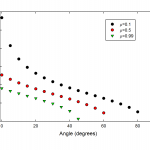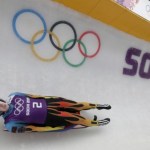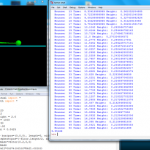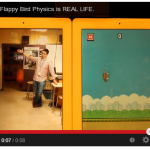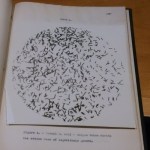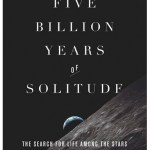
Ages and ages ago, I posted the picture that's the "featured image" above, and asked people to submit physics comments about it. Then I got distracted by a series of shiny things, and never did anything with the handful of responses I got. Because I'm a Terrible Person.
Anyway, it's long overdue, but here are the responses, with some comments from me. The first to send me something was Keith Hester, who emailed:
I find quite intriguing the lengthy unbroken --- and seemingly unsupported --- extension of snow that has slid over the left edge of the roof. The coefficient of friction between…
In which Rhett and I talk about color vision, undergraduate research projects, blog networks, outreach activities, and how thermodynamics is a lie.
Things mentioned in the discussion:
The Flame Challenge
My post about looking at computer monitors with a spectrometer
Physics Quest
I'm inadvertently doing a bit of product placement here-- the T-shirt I'm wearing is from Surviving the World, and the water bottle I'm drinking from is from the Institute for Quantum Computing in Waterloo. I expected it to be colder in my office on campus, but it was actually pretty warm, so I took off the other…
About three hours from now, Rhett Allain and I are doing another "Uncertain Dots" Google hangout. We don't have a real clear topic, so if you have any questions about physics, academia, blogs, etc. that you'd like to hear us answer, this would be a great time to ask them, via comments here, email, or tweeting at @rjallain or @orzelc. If you like hashtags, #UncertainDots is a good one, but longer than either of our Twitter names...
This year's "Flame Challenge" is to explain color in terms an 11-year-old can follow. I have opinions on this subject, a background in AMO physics, and access to scientific equipment, so I'm putting something together. In the course of this, though, it occurred to me to wonder how my different portable computing devices process color. And since I have access to an Ocean Optics USB4000 spectrometer, I can answer this question in more detail than anybody needs.
So, I have three principal electronic devices that I use to do computer-type things: a Moto X smartphone, an iPad, and a Lenovo…
In the previous post about luge, I mentioned that there was one thing that came up when Rhett and I were talking about this, namely why there are differences in times between racers. The toy physics model I set up last time suggests that the difference between riders is only a matter of aerodynamics-- two riders with the same mass and cross-sectional area ought to achieve the same speed. So why do they all get different times?
Well, if the sleds and other gear were all identical and locked into tracks, then mass and aerodynamics would be the entire story. But they're not-- the rules allow for…
The outrage of the moment in academic circles is this Nick Kristof column on how academics need to be more engaged with a broader public. And it's really impressive how he manages to take an idea that I basically agree with-- I regularly give talks on the need for scientists to do more outreach via social media-- and present it in a way that's faintly insulting.
This came to my attention via Chuck Pearson on Twitter, who also has a long blog response. There are also good responses from Edward Carr and Corey Robin, and the hashtag Chuck launched, #EngagedAcademics includes lots of counter-…
In the Uncertain Dots hangout the other day, Rhett and I went off on a tangent about the physics of the Olympics, specifically the luge. If you're not familiar with this, it's basically psycho sledding: people riding tiny little sleds down a curved track at 80mph.
The "featured image" above shows Erin Hamlin of the US women's luge team during a training run (AP photo from here); she went on to win a bronze medal, the US's first in individual luge, so congratulations to her. The photo gives you an idea of what's involved: tiny sled, icy track, curved walls.
(In the Winter Olympics context,…
We got over a foot of snow yesterday and today, so schools are closed. Except Union is a residential college, so we never close, which means I have to dig my car out all the same. Which I did, clearing a path to the unplowed street, then took Emmy for her morning walk. During which, of course, the town snow plows came around and filled in the end of our driveway again...
As I was digging out again, I was struck by just how far the snow had gone up the driveway-- I paced off about six meters from the edge of the road to the farthest clumps thrown up the driveway. As a way to distract myself…
I didn't advertise it heavily this time, but Rhett and I did another G+ hangout yesterday, and the video is online now:
We talked for a while about the wonders and importance of VPython coding (including some "Oh, I should totally do that..." moments), where we get post ideas (including a discussion of luge physics), briefly about how we put stuff together for posts, and a bit more about physics education research and why it's really difficult.
I had hoped to throw together a quick post about the luge thing for today, but that's probably not going to happen, so you'll have to settle for the…
Kevin Drum and Aaron Carroll report on a new study of the effect of new grocery stores opening in "food deserts" in poor neighborhood. The study is paywalled, so I can't speak to the whole thing, but both of them quote similar bits making the same point: no statistically significant effects on the BMI of people in the neighborhood, and very few signs of healthier eating in general.
This is one of those studies that probably belongs in the Journal of "Well, Yeah...", because it doesn't surprise me a bit. Not for reasons that can be addressed via policy measures-- Drum quotes the study saying "…
Last week, Rhett did a post on animating a bouncing ball in VPython. This was mostly making a point about the distinction between real simulation and animation, along the lines of yesterday's post on social construction of videogame reality. But, of course, my immediate reaction was, "That's not how a bouncing ball looks..." This is how a bouncing ball looks:
(As you can see from the watermark, I'm trying out a new video editor...)
This is footage of four different types of balls bouncing on a lab cart in our stockroom, shot in gratuitous slow motion (240 fps) because I'm still playing…
One of the more annoying points of contention back in the days of the Sokal hoax and the "Science Wars" was an argument over social construction. This is, loosely speaking, the idea that our understanding of the world is not strictly rational and objective, but is heavily influenced by interactions with other people, and the culture in which we live. The idea originally arose in literary academia, but expanded to be applied to basically everything, including science.
At bottom, this is probably the best and most useful idea to come out of whatever collective "-ism" you want to use to refer…
SteelyKid's gotten a bunch of press here recently, so it's time to give her brother his due. So here's a cute picture of The Pip from this afternoon (as the "featured image"-- if you read via RSS, you'll have to click through). He's wearing a "superhero cape" made from a fuzzy blanket, because SteelyKid was bouncing around in a cape made from an entire twin bed sheet.
Of course, the effect here is maybe less superheroic than monastic, especially with his hands folded like that. This could be a photo of Brother Pip of the Order of Little Green Frogs.
And yet another possibility would be that…
SteelyKid's class at her after-school day care has been learning about space for the last month or two (the program is very flexible-- the teachers ask the kids what they want to learn about, and then they spend however long on that topic the kids like), so we've been getting a lot of tidbits about astronomy related to us during car trips and dinner conversation. Last night, there was an open house at the Union College Observatory, so I picked her up a little early, and took her to campus to look through the big telescope (20-inch Cassegrain, for those who care about such things). This served…
A couple of days ago, John Scalzi posted a writing advice open thread, asking people to share the best advice they'd gotten on the craft of writing. There's a lot of good stuff in there, much of it fairly specific to fiction writing-- stuff about plotting, the use of synonyms for "said," how to keep track of who's speaking, etc. As someone who's very much an outsider to that side of the writing business, it's interesting to read, but not that directly useful (I do have long stretches of dialogue in the How-to-Teach books, and occasionally needed to worry about the "said" thing there, but that…
Both SteelyKid's kindergarten and the snow-day day-care program that the kids go to were closed today, which kind of threw a wrench in things. But it's also kind of fun, as I got to spend some time playing outside with SteelyKid on her play set in the snow. The "featured image" above is a cell-phone snap from this, and I got three short video clips of her going down the slide.
Of course, it's kind of stupid for these to be three separate YouTube clips, but when I went to stick them together using Windows Movie Maker (which is what I've used for this sort of thing in the past), it turns out…
Back in the fall, I did a bunch of write-ups of old Master's theses that we found when clearing some space in a storage room. I got away from this because I was busy working on the book, but I have a few more that I pulled out to look at, and since all the other topics sucking up Internet energy at the moment are stupid or depressing, it seems like a good time to get back to these.
So, this is a thesis from 1934 by a fellow named Thomas Dietz, a combination of names that is common enough to make him less Google-able than you might want. This does seem to have been moderately significant work…
This week's hangout with Rhett Allain, in which we talk about how we got into physics, how we find stuff to read, what we enjoyed on physics blogs this week, what we do and don't like about Twitter, and the revenge of the Sith.
The specific blog posts we mentioned:
Frank Noschese's analysis of gravity in Flappy Birds
Ethan Siegel on Hawking and black holes
Bee at Backreaction on what Hawking really said
Timothy Burke on "administrative bloat" and faculty control
Dr. SkySkull on infinite series
Physics Buzz apologizing for starting the infinite series thing
Matthew Francis on polarization in…
There was a flurry of re-shares last week for this article about Yale shutting down a site that aggregated student course evaluations, which is fine as far as it goes, but repeats a stat that really bugs me:
About 43 percent of college letter grades in 2011 were A’s, up from 31 percent in 1988 and 15 percent in 1960, a 2011 study found. Over roughly the same span, the average amount of studying by people enrolled in college declined almost 50 percent, a 2011 study found, from 25 hours per week to 13 hours.
This is less bad than the usual, thanks to including the 1988 point, but it's still…
It's taken me a disgracefully long time to finish the review copy of Lee Billings's Five Billion Years of Solitude I was sent back in the fall, mostly because I didn't read anything not immediately related to the book-in-progress for most of November and all of December. Which is to say, the long delay is not in any way a reflection of the quality of this book, which is excellent.
The title comes from the observation that the span from when life arose on Earth to the distant future when the expanding Sun will swallow the planet entirely is around five billion years. The span when the planet…


